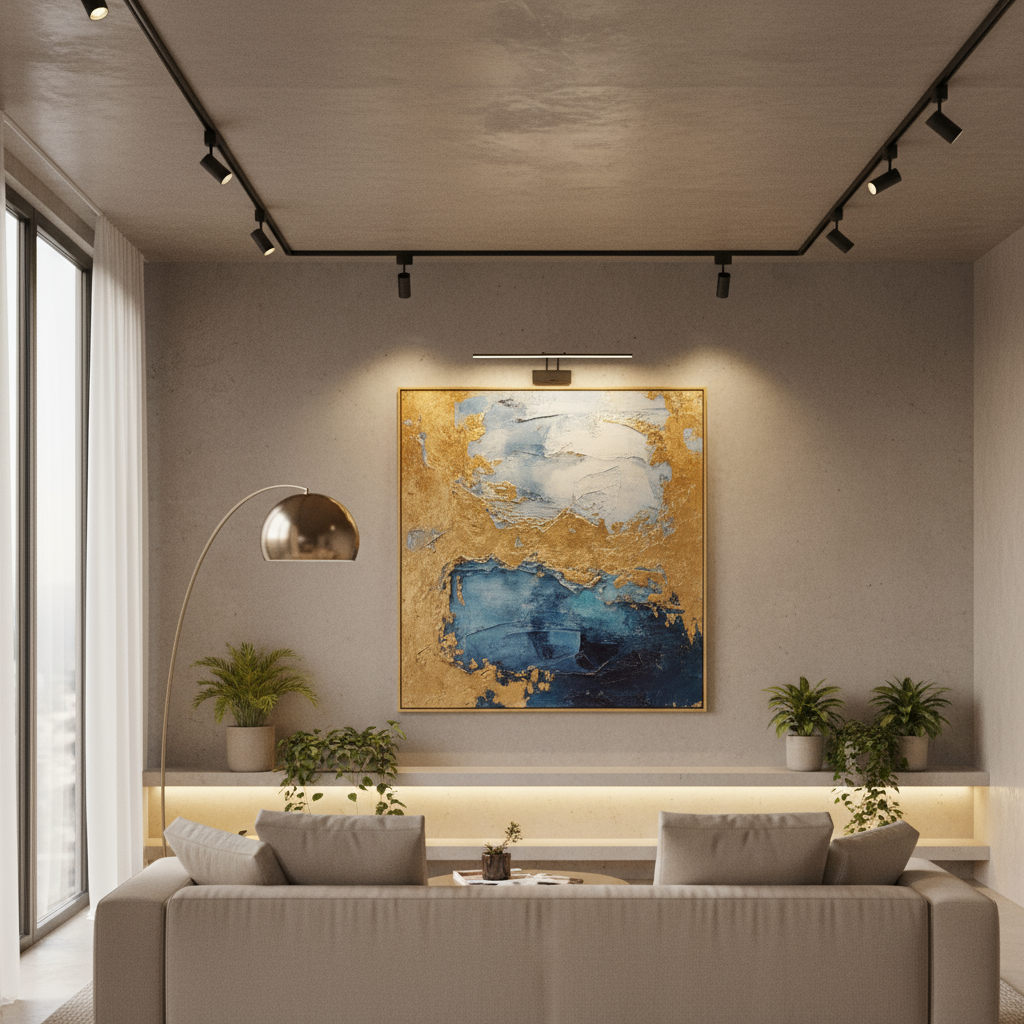Key Takeaways
- Position lights at a 30-degree angle to minimize glare and maximize artwork visibility
- Choose high CRI (90+) LED lights for accurate color reproduction
- Protect artwork from UV damage with proper lighting placement and LED technology
- Layer different lighting types: ambient, accent, and task lighting for optimal display
Expert Methodology
This guide combines insights from art lighting expert David Munson, professional lighting design principles, and practical experience from gallery installations. All recommendations are based on industry standards and proven techniques used in museums and high-end residential displays.
Proper lighting can transform artwork from a barely visible wall hanging into a stunning focal point that commands attention and admiration. Whether you're displaying a treasured family photograph, an original painting, or a carefully curated art print, the right lighting technique makes all the difference. According to lighting specialists, most homeowners underestimate the dramatic impact proper illumination can have on their art collection.

Dramatic before-and-after comparison showing the transformative power of proper art lighting
Understanding the Science of Art Lighting
The Critical 30-Degree Rule
Professional lighting expert David Munson emphasizes that lights should be positioned so the beam hits the center of the artwork at a 30-degree angle. This precise positioning minimizes glare while ensuring even illumination across the entire surface.

Technical diagram illustrating the optimal 30-degree lighting angle for artwork
Why 30 Degrees Works
- Eliminates Hot Spots: Prevents concentrated bright spots that overpower artwork details
- Reduces Glare: Minimizes reflective glare on glass-covered artwork
- Even Coverage: Ensures uniform light distribution across the entire artwork surface
- Professional Standard: Used in museums and galleries worldwide for optimal viewing
Color Rendering Index (CRI): The Quality Measure
Color Rendering Index (CRI) measures how accurately a light source reveals true colors compared to natural sunlight. For artwork display, experts recommend a CRI of 90 or higher to ensure paintings, prints, and photographs appear in their intended colors.

LED, Halogen, and Incandescent bulb comparison showing differences in color rendering quality
CRI Recommendations by Space
Art Galleries & Museums: CRI 95-100 for critical color accuracy
Residential Displays: CRI 90+ for home art collections
Commercial Spaces: CRI 85+ minimum for professional environments
Types of Art Lighting Systems
Track Lighting: The Professional Choice
Track lighting offers maximum flexibility for illuminating artwork, which is why it's the preferred choice in museums and galleries. The adjustable fixtures allow you to direct light precisely where needed and easily reposition when you rearrange your collection.

Professional gallery setup demonstrating multiple lighting techniques: track lights, picture lights, and wall washers
Track Lighting Advantages
- Adjustability: Reposition lights as you change artwork
- Wide Coverage: Ideal for gallery walls with multiple pieces
- Professional Look: Clean, minimalist aesthetic
- Dimming Capability: Control intensity for different moods
Picture Lights: Classic Elegance
Picture lights mount directly on the wall or frame, providing intimate illumination that draws viewers closer to the artwork. These fixtures work particularly well for traditional artwork above mantels or in formal dining rooms where the decorative element of the light fixture enhances the overall design.
Wall Washers: Uniform Illumination
Wall washers create broad, even light distribution across large wall surfaces, making them ideal for oversized artwork or gallery walls with multiple pieces. These fixtures eliminate shadows and provide consistent illumination without creating focal points on the lighting hardware itself.
Protecting Your Investment: UV and Heat Considerations
The Hidden Danger of UV Damage
Direct sunlight and certain artificial light sources emit ultraviolet radiation that can permanently fade pigments, deteriorate paper, and damage canvas over time. Professional conservators recommend positioning artwork away from windows or using UV-filtering glazing and LED lights that emit minimal UV radiation.

Comparison showing UV damage risks versus LED-safe lighting protection
Protection Strategies
- Choose LED Technology: Emits virtually no UV radiation
- Control Natural Light: Use window films or position art on interior walls
- Monitor Light Levels: Keep illumination between 150-300 lux for most artwork
- Time Limitations: Consider motion sensors to reduce total exposure time
Common Lighting Mistakes to Avoid
Even well-intentioned lighting installations can detract from artwork when common mistakes occur. Understanding these pitfalls helps ensure your lighting enhances rather than hinders your art display.

Common lighting mistakes: harsh glare, uneven shadows, and improper positioning
Mistakes That Sabotage Your Display
- Overhead Lighting Only: Creates harsh shadows and uneven illumination
- Too Close to Windows: Competing light sources wash out artificial lighting
- Wrong Color Temperature: Cool lights make warm artwork appear dull
- Inadequate CRI: Colors appear muted and lifeless
- Single Point Sources: Creates hot spots and dark areas
Layered Lighting Approach
Creating Depth and Ambiance
Professional lighting design relies on three types of lighting working together: ambient (general room lighting), task (functional lighting), and accent (highlighting specific features like artwork). This layered approach prevents artwork from appearing isolated or artificially spotlit.
The Three-Layer System
Ambient Lighting (30-40%): General room illumination from ceiling fixtures or recessed lights
Task Lighting (40-50%): Functional lighting for reading areas, work surfaces
Accent Lighting (10-20%): Dedicated artwork illumination that's 3-5 times brighter than ambient levels
Installation Best Practices
Step-by-Step Professional Setup
Professional Installation Process
- Plan the Layout: Map artwork locations and lighting positions on paper first
- Calculate Distances: Measure the distance needed to achieve 30-degree angles
- Install Track Systems: Position tracks parallel to walls at calculated distances
- Test Light Positions: Use temporary fixtures to verify coverage before final installation
- Fine-tune Angles: Adjust each fixture for optimal coverage and minimal glare
- Add Dimming Controls: Install dimmers for mood adjustment and energy savings
Stone & Gray: Lighting Your Art Collection
At Stone & Gray, we understand that proper lighting transforms artwork from decoration into the focal point of your space. Our carefully curated collection of prints deserves lighting that reveals every detail and color nuance as the artist intended.

Stone & Gray art print showcased with professional lighting in a contemporary setting
Our Lighting Recommendations for Art Prints
- LED Track Lights: 3000K color temperature, 90+ CRI for warm, accurate colors
- Adjustable Beam Angles: 24-40 degree beam spread depending on print size
- Dimming Capability: 0-10V or TRIAC dimmers for mood control
- UV Protection: LED technology with minimal UV emission
Featured Art Prints Perfect for Your Lighting Project
Expert Resources and Further Reading
Professional Resources
- David Munson Art Lighting Expertise - Professional techniques from FineArtLight™
- Alcon Lighting Design Guides - Technical specifications and best practices
- CRI Technical Information - Color science and measurement standards
- The Artling Professional Guide - Gallery-standard lighting techniques
Transform Your Space Today
Proper art lighting isn't just about illumination—it's about creating an emotional connection between viewer and artwork. When you implement these professional techniques, your art collection becomes a dynamic element that enhances your entire living space.
Ready to Illuminate Your Art?
Start with high-quality artwork that deserves professional lighting. Explore our collection of curated prints and discover pieces that will become the stunning focal points of your newly illuminated space.
Remember: The right lighting can make a R 449 print look like a million-rand masterpiece.
Whether you're lighting a single statement piece or an entire gallery wall, these professional techniques ensure your artwork receives the attention and admiration it deserves. The investment in proper lighting pays dividends in the enhanced beauty and impact of your art collection for years to come.










